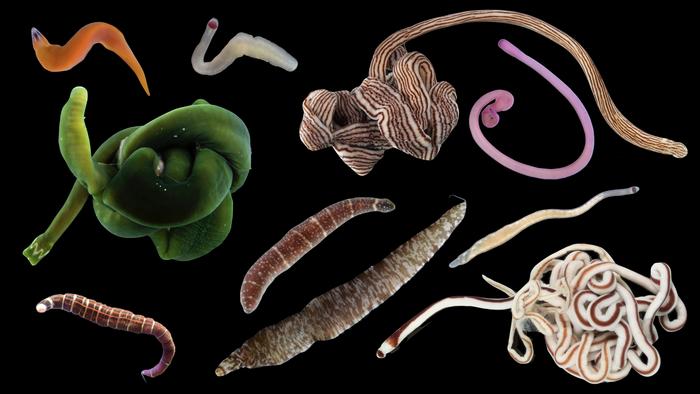In the shadowy depths off the coast of Oman, a remarkable discovery has reshaped our understanding of marine biodiversity. Recent explorations have unveiled over 100 species of ribbon worms—nemerteans—most of which are previously unknown to science. These creatures, often overlooked due to their small size and cryptic habitats, embody a significant gap in our knowledge of oceanic life. The findings, documented in a comprehensive study published in PeerJ, underscore a striking biodiversity hotspot in the Arabian Sea, a region heretofore little sampled for these elusive invertebrates.
Ribbon worms exhibit a bewildering range of sizes and colors. While many are slender and delicate, sometimes thinner than a toothpick, others can attain lengths rivaling that of the largest blue whales. Their color spectrum spans from inconspicuous browns and beiges to vivid neon pinks and electric blues. These bright hues serve a dual function: they are both an alluring spectacle and an aposematic warning system against predators, signaling the presence of potent toxins within their tissues. These toxins allow ribbon worms not only to defend themselves but also to capture prey with astonishing efficiency.
Svetlana Maslakova, a leading expert in nemertean biology and the principal investigator of this study, emphasizes how limited our current knowledge remains. Despite over 1,300 formally described species of ribbon worms worldwide, these represent barely a fraction—an estimated 10%—of the actual diversity lurking beneath ocean surfaces. The substantial number of new species identified in Oman reveals just how underexplored tropical marine habitats remain, even in regions considered biologically rich.
A significant reason for this biodiversity blind spot lies in geographic sampling biases. Historically, research has concentrated on temperate waters of Europe and North America where about one-third of named nemertean species reside. Tropical zones, synonymous with overall marine species richness, have seen comparatively less systematic survey effort. Oman’s coastal ecosystems thus represent a crucial frontier. Unique ecological interactions arise there, such as the rare coexistence of kelp forests alongside coral reefs, creating habitats unlike those commonly known.
The methodology employed by Maslakova’s team integrates classical taxonomy with modern molecular techniques. Traditional morphological identification is often insufficient when many ribbon worms look deceptively similar. DNA barcoding offers an indispensable tool, enabling precise delineation of species boundaries, tracking of geographic distributions, and revealing evolutionary relationships. This first-ever molecular assessment of nemerteans in the Arabian Peninsula has significantly expanded the known range and phylogenetic tree of this phylum.
Ribbon worms’ predation strategies are equally fascinating from a functional and biochemical perspective. Their hallmark feature, the proboscis, is a specialized, extendable organ used to ensnare prey. In some lineages, the proboscis bears a stylet—a minute, needle-like spine—that punctures prey tissue, injecting a potent venom combined with digestive enzymes. Other species have a branching proboscis structure reminiscent of human lung bronchi, enabling them to entrap prey physically while toxins diffuse through the victim’s body. These adaptations highlight ribbon worms as apex invertebrate predators within benthic communities.
Once immobilized, prey items ranging from smaller worms and mollusks to crustaceans and even fish are consumed either whole or through external digestion. Stylet-bearing species await enzymatic liquefaction of tissues before ingesting the nutrient-rich fluid, a remarkable evolutionary adaptation favoring feeding efficiency. This carnivorous lifestyle positions ribbon worms as key nodes within marine food webs, influencing population dynamics and ecosystem structure.
Despite their ecological prominence, ribbon worms remain vulnerable to environmental change. Rapid declines due to climate change and habitat degradation threaten countless species, many yet undescribed. The specialized nature of their habitats, combined with limited dispersal capabilities, exacerbates their susceptibility. Loss of ribbon worm diversity could trigger cascading ramifications within their ecosystems, underscoring the urgency of biodiversity assessment and conservation in understudied marine regions.
Beyond their ecological role, nemerteans harbor immense biomedical potential rooted in their unique toxins. Compounds isolated from ribbon worms have demonstrated efficacy against neurological ailments, such as schizophrenia and Alzheimer’s disease, providing a promising avenue for novel pharmaceutical development. Unraveling the biochemical pathways and genetic basis of their venom production could unlock new therapeutic molecules, further incentivizing the protection and study of these enigmatic creatures.
Efforts to locate and document ribbon worms are arduous, requiring painstaking fieldwork. Researchers employ techniques such as turning over stones during low tide, scuba diving, and collecting dead coral rubble to trap emerging worms in controlled seawater containers. Their secretive habits—hiding in crevices, burrowing in substrates, or tucking into algal mats—make comprehensive surveying challenging, contributing to the underestimation of true diversity.
The recent expedition to Oman not only doubled the number of DNA-barcoded nemertean species known from the Indo-West Pacific but also highlighted a striking degree of endemism, with 93% of observed species apparently restricted to the Arabian region. This finding has profound implications for biodiversity patterns, evolutionary biology, and conservation prioritization. The Arabian marine ecosystems represent an invaluable reservoir of life that demands further exploration and protection.
As scientists continue to peel back layers of oceanic mystery, the ribbon worms of Oman serve as a vivid reminder of both our biological ignorance and the richness yet to be understood. This discovery challenges marine biologists, ecologists, and conservationists to refocus efforts on neglected habitats and taxa. The intertwining of advanced molecular tools with traditional natural history studies heralds a new era in documenting Earth’s biodiversity before it is irrevocably lost.
Subject of Research: Ribbon worm (Nemertean) diversity and distribution in Oman
Article Title: A hundred species, mostly new—first assessment of ribbon worm diversity and distribution in Oman
News Publication Date: 28-May-2025
Web References:
Image Credits: Svetlana Maslakova
Keywords: Invertebrates, Discovery research, Worms, Extinction, Biodiversity conservation, Biodiversity, Aquatic animals, Marine ecosystems, Marine biology




